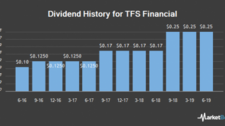Upgrade & Secure Your Future with DevOps, SRE, DevSecOps, MLOps!
We spend hours on Instagram and YouTube and waste money on coffee and fast food, but won’t spend 30 minutes a day learning skills to boost our careers.
Master in DevOps, SRE, DevSecOps & MLOps!
Learn from Guru Rajesh Kumar and double your salary in just one year.
Source:- hobackherald.com
After a recent indicator scan, we have noted that Span A is currently higher than Span B for shares of Tfs Financial Corp (TFSL). Traders may be paying close attention as this signal may indicate a possible bullish move.
Strictly technical traders typically don’t pay a whole lot of attention to fundamental factors such as value, competition, or company management. Technical analysts want to figure out trends based on indicators, charts, and prior price data. These types of traders are usually highly active and hold positions for short periods of time in order to capitalize on short-term price fluctuations. Active traders may be quick to unload a position if it does not pan out as expected. Technicians often pay a great deal of attention to support and resistance levels. These are levels where traders believe a specific stock will either see a bounce or a pullback.
Tfs Financial Corp (TFSL) presently has a 14-day Commodity Channel Index (CCI) of -40.69. Typically, the CCI oscillates above and below a zero line. Normal oscillations tend to stay in the range of -100 to +100. A CCI reading of +100 may represent overbought conditions, while readings near -100 may indicate oversold territory. Although the CCI indicator was developed for commodities, it has become a popular tool for equity evaluation as well. Checking on another technical indicator, the 14-day RSI is currently sitting at 55.23.
Many traders will use a combination of moving averages with different time frames to help review stock trend direction. One of the more popular combinations is to use the 50-day and 200-day moving averages. Investors may use the 200-day MA to help smooth out the data a get a clearer long-term picture. They may look to the 50-day or 20-day to get a better grasp of what is going on with the stock in the near-term. Presently, the 200-day moving average is at 16.17 and the 50-day is 17.11.
Taking a look at other technical levels, the 3-day RSI stands at 25.86, the 7-day sits at 47.36 and the 14-day (most common) is at 55.23. The Relative Strength Index (RSI) is an often employed momentum oscillator that is used to measure the speed and change of stock price movements. When charted, the RSI can serve as a visual means to monitor historical and current strength or weakness in a certain market. This measurement is based on closing prices over a specific period of time. As a momentum oscillator, the RSI operates in a set range. This range falls on a scale between 0 and 100. If the RSI is closer to 100, this may indicate a period of stronger momentum. On the flip side, an RSI near 0 may signal weaker momentum. The RSI was originally created by J. Welles Wilder which was introduced in his 1978 book “New Concepts in Technical Trading Systems”.
The Williams %R is designed to provide a general sense of when the equity might have reached an extreme and be primed for a reversal. As a general observance, the more overbought or oversold the reading displays, the more likely a reversal may take place. The 14 day Williams %R for Tfs Financial Corp (TFSL) is noted at -47.06. Many consider the equity oversold if the reading is below -80 and overbought if the indicator is between 0 and -20.
At the time of writing, the 14-day ADX for Tfs Financial Corp (TFSL) is standing at 39.88. Many chart analysts believe that an ADX reading over 25 would suggest a strong trend. A reading under 20 would suggest no trend, and a reading from 20-25 would suggest that there is no clear trend signal. The Average Directional Index or ADX. The ADX was created by J. Welles Wilder to help determine how strong a trend is. In general, a rising ADX line means that an existing trend is gaining strength. The opposite would be the case for a falling ADX line.
There are plenty of technical indicators that traders can choose to follow. With so many different signals to follow, traders may choose to focus on a small number of indicators to start. Many technical analysts will use a combination of different signals in order to help identify the best entry and exit points of a trade. Becoming a master at spotting trends and creating charts may seem impossible for the novice investor. Taking the time to fully understand the methods behind the indicators may help the trader with trying to sort everything out. Studying up on the theory behind some of the more popular indicators may help the trader understand exactly what they are doing when setting up their charts.
